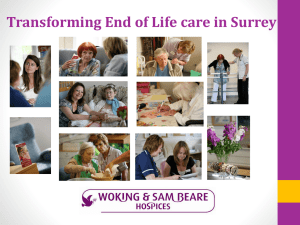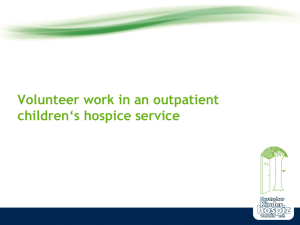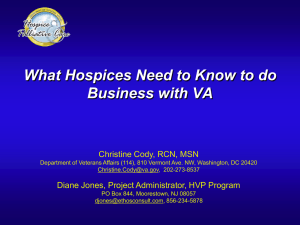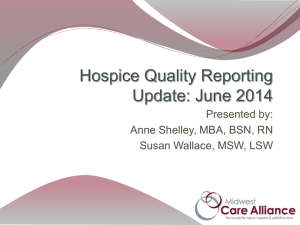NAHA_2009_HospiceCapReformSlidesExcerpts (web)
advertisement
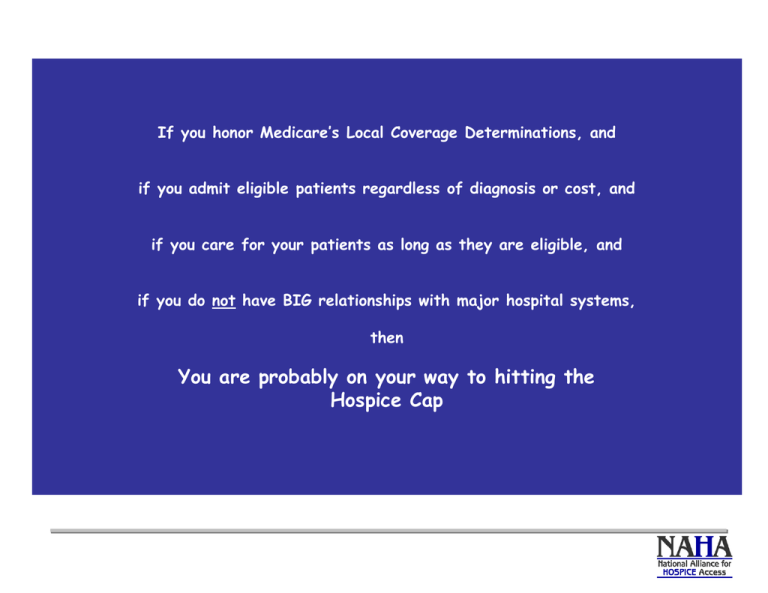
If you honor Medicare’s Local Coverage Determinations, and if you admit eligible patients regardless of diagnosis or cost, and if you care for your patients as long as they are eligible, and if you do not have BIG relationships with major hospital systems, then You are probably on your way to hitting the Hospice Cap National Alliance for Hospice Access (NAHA) Grassroots Coalition of Over 500 Independent Hospices in 29 States New, Old, Rural, Inner City, For-Profit, Non-Profit … No “deep pockets” Disproportionately serve rural, minority, economically disadvantaged 2 Agenda Why are more and more hospices and patients being harmed by the Cap? 2008 Moratorium Legislation Barriers to Cap Reform 2009 Interim Hospice Reform Note: Surviving until Cap Reform - Cap calculation regulation ruled invalid by federal court 3 Why are more and more hospices and patients being harmed by the Cap? 4 1982 Benefit capped BOTH beneficiary and provider Most patients had cancer; never hit the 210 day limit 1998 benefit expansion: Removed cap on beneficiary Local Coverage Determinations (LCDs) gave “equal access” to non-cancer patients 1998 benefit expansion created fundamental conflict: Only Medicare benefit where beneficiary has unlimited benefit BUT provider is capped Flawed LCDs create length of stay far beyond what the Cap allows Dementia LCDs result in length of stay that cause hospices to exceed the Cap. Heart, FTT and Pulmonary LOS may be similar. Illustrative Hospice Dementia Patient LOS Distribution 100% % of Dementia Patients Surviving 75% 35% of dementia patients stay longer than 180 days 50% 25% stay longer than 330 days 10% stay longer than 2 years 25% 180 days 0% 2 s ar ye 5 66 5 60 5 54 5 48 5 42 5 36 0 30 0 24 0 18 0 12 60 5 Review of the literature agrees: Medicare’s hospice LCDs have never empirically validated and appear to be of no value in predicting a patient’s hospice length of stay. “the guidelines have never been shown to be useful in identifying patients who will actually die within 6 months …” (1) “The prognostic criteria . . . were largely ineffective in predicting which seriously ill hospitalized patients with COPD, CHF, or ESLD have a prognosis of 6 months or less (2) Dementia LCDs are “ … not derived from empirical data, do not accurately predict 6-month survival, and cannot be applied to the majority of patients with dementia whose disease does not progress linearly.” (3) “… hospice Medicare guidelines were not valid in predicting survival of these patients. None of the variables included in the hospice dementia Medicare guidelines were related to survival. . .” (4) “From a public policy perspective, it is troubling to see that these guidelines were introduced without empirical data demonstrating that they accurately predicted survival …” (4) 1. 2. 3. 4. 6 Abrahm et al Chest. 2002;121:220-229 Fox et al JAMA. Volume 282, Number 17, November 3, 1999. Mitchell et al JAMA. Volume 291, Number 22, June 9, 2004 Schonwetter et al American Journal of Hospice and Palliative Care. Volume 20, Number 2, March/April 2003 Cap demands doubled every year 2000 through 2005 2006 Cap Estimate: +50% to $300 million, 400 hospices, 30+ states Cap Demands by Year thru 2006 Est Hospices Exceeding Cap ($millions) 500 $300 2006 $250 $200 $150 $300 million +50% vs 2005 2006 400 hospices 300 14% of total Triple 2004 +50% vs 2005 200 $100 $50 100 $0 0 06 20 05 20 04 20 t Es t Es t Es 06 20 t Es 05 20 04 20 03 20 02 20 01 20 00 20 99 19 7 400 2006 Cap Demands* 400 hospices in 30+ states receiving Cap Demands for $300 million, +50% vs 2005 % of hospices receiving Cap demands % of Hospices Exceeding Cap in 2006 Dark red: Over 20% Lighter Red: 10% to 20% Pink Under 10% White None 8 Hospital-owned Hospices appear to be structurally insulated from the Cap 20% of all hospices are hospital-owned but this varies widely by region/state. Patients referred to hospices from hospitals have dramatically lower LOS, across all diagnoses Hospitals own most hospices in Northcentral / Northwest states, explaining low hospice LOS. 50% 73% 93% 66% 54% 93% 60% 70% Hospital ownership of Hospices Dark Gray: Over 50% Lighter Gray: 20% to 49% White: Under 20% 9 Hospices in Certificate of Need states also appear to be structurally insulated from the hospice cap: • • Timely patient access is lower in CoN states, especially for non-cancer diagnoses Hospices in CoN states, especially Florida, have more very short LOS patients, probably reflecting a higher share of referrals from hospitals 41% 29% 25% 34% 29% 34% D.C. 25% 43% 38% 37% Hawaii 25% 10 56% Congress and Medicare intended 1998 hospice benefit expansion to increase access and length of stay. CMS Administrator DeParle - September 2000 “There is a disturbing misperception that hospices and beneficiaries will be penalized if a patient lives longer than six months. Nothing could be further from the truth … Let me be clear: In no way are hospice beneficiaries restricted to six months of coverage. There is no limit on how long an individual beneficiary can receive hospice services, as long as they meet the eligibility criteria.” 11 Hospice is “the rare situation whereby something that improves quality of life also appears to reduce costs.”– Duke University 2007 12 “Hospice use reduced Medicare program expenditures during the last year of life by an average of $2,309 per hospice user” “Increasing the length of hospice use for 7 in 10 Medicare hospice users would increase savings” Medicare’s quality and economics would both benefit if “… more effort was put into increasing short stays as opposed to focusing on shortening long ones.” Hospice saves money for average length of stays up to 233 days for cancer patients and 154 days for non-cancer “Efforts to curtail longer lengths of hospice use could have a chilling effect … further shortening length of use prior to death.” “Managing Cap” perversely forces hospices to seek out patients who will die more quickly, and to withhold care from those who are clearly eligible but less predictable. 13 “Desirable” = “Cap surplus” = patients who die quickly Cancer Referrals from hospitals “Undesirable” = “Cap deficit” = patients who live longer than expected Non-cancer patients Patients referred while still living at home (patients with prior hospice service) “Manage Cap” = withhold access from non-cancer patients still at home When your hospice hits the Cap … you may Wonder what you have done wrong (answer: “nothing”) Review all of your admissions and recert practices and probably find that all your patients are eligible, and always have been. Not have the money, ask CMS for a 5 year repayment plan and consider filing an appeal or lawsuuit Try to “manage the Cap”, but then discover you’re going to hit the Cap next year too Struggle with ethical decisions; should you: retrain your people to not admit eligible non-cancer patients? discharge eligible patients? Lay off hard-working caregivers you have known for years, and struggle to find other hospices that will care for your patients Lose your job, and your hospice too if your family owns it 14 2008 Moratorium Legislation PATH Act March 2008 Moratorium on calculation and collection of 2006, 2007 and 2008 Cap Will not become law; not attached to minimalist 2008 Medicare legislation Congress wants fiscally responsible solutions 15 Barriers to Cap Reform Hospice industry is unnecessarily divided MedPAC staff Congress supports hospice, but wants fiscally responsible reform 16 Hospice industry is unnecessarily divided. 17 “Only” 400 hospices hit the Cap in 2006, 50% more than 2005 Some hospices structurally insulated from the Cap have disproportionate influence, and appear to believe that payment reform is inconsistent with Cap reform. Large urban chain hospices Large urban non-profits, especially in Certificate of Need states Hospices that support Cap reform must unite and speak out Cap reform is fiscally responsible and consistent with payment reform NAHA: the only national voice for independent hospices, and for Cap reform MedPAC staff is advocating against hospice Cap reform, and for cutting hospice access and spending. MedPAC staff storyline is factually incorrect, but effectively avoids critical public policy issue of hospice access for non-cancer patients, by demonizing longer patient length of stay MedPAC storyline Hospice spending is growing too fast, driven by new for-profit hospices Patient LOS is increasing mainly because providers are scamming the system Medicare local coverage determinations (eligibility criteria) that are not evidence-based and that cause very long stays for non-cancer patients are not an important issue Hospices that hit the Cap are bad actors 18 MedPAC staff: Hospice access is good and Medicare hospice spending is growing too fast NAHA: 42% hospice access means 1 million Seniors die each year without hospice. Medicare saves money as hospice grows, $1.8 billion in 2006 alone. $2,000 100% % Hospice Access $1,750 (Medicare Hospice Admissions as % Medicare Deaths) 80% Medicare Net Savings from Hospice $ Millions per year $1,500 1 million Seniors $1,250 60% $1,000 40% $750 $500 20% $250 0% $0 06 20 04 20 02 20 00 20 98 19 96 19 94 19 92 19 90 19 88 19 86 19 84 19 19 19 19 19 19 19 19 19 19 20 20 20 20 84 86 88 90 92 94 96 98 00 02 04 06 In 2006 only 42% of Medicare decedents received hospice care. Patient access ranges from 69% in Arizona to 25% in NY. Only 11 states were over 50%. % Medicare Decedents electing hospice Dark Gray: 50% to 69% Lighter Gray: 35% to 49% White: Under 35% 20 MedPAC staff: New for-profit hospices are responsible for hospice growth. (implying this is “bad” and driven by admissions of ineligible patients) NAHA: 67% of growth has come from “older established” hospices and non-profits. Medicare Hospices 2006 2000 Growth 3,034 1,976 1,058 Hospice Days 68.6 million 24.3 million 44.3 million Source of Growth 21 “New” for-profit hospices 907 (85%) “New” non-profits “Older” established hospices 151 na (15%) 14.5 million 1.3 million 28.5 million (33%) (3%) (64%) MedPAC staff: Growth in length of stay is due to for-profit hospices scamming the system NAHA: LOS grew mainly among longest-staying 10% of patients, in only 3 non-cancer diagnoses. 75% of patients’ LOS remained unchanged and short, and appears to be driven mainly by Medicare’s flawed LCD eligibility criteria, not a conspiracy among for-profit providers. 900 2008 / 1998 Hospice Patient Length of Stay Distribution (5 Percentile Groups) 810 Growth in LOS, 2008 vs 1998 720 1998 LOS by 5-Percentile Groups 630 540 450 360 270 180 90 0 0 22 -5 6 -1 0 11 -1 5 16 -2 0 21 -2 5 26 -3 0 31 -3 5 36 -4 0 41 -4 5 46 -5 0 51 -5 5 56 -6 0 61 -6 5 66 -7 0 71 -7 5 76 -8 0 81 -8 5 86 -9 0 91 -9 5 96 -9 9 MedPAC staff: LCDs are not evidence-based, cause long stays among certain diagnoses, and hospices are inventing their own eligibility criteria, but this is not a factor in LOS growth. March 2009 Report to Congress LCDs may need to be strengthened to effectively identify the appropriate point in a patient's terminal illness for admission… It would be difficult, however, to develop a definitive "cookbook” … some hospices have developed additional guidelines on eligibility criteria to ensure that patients are appropriately admitted … Hospices will need to be more judicious with terminal diseases that typically have long stays … Hospices that once relied on diagnosis alone when accepting a referral may now implement greater controls, such as following admissions criteria developed by some hospices that better identify patients entering the last six months of life. NAHA: Criteria for access to hospice vary by state, community and hospice LCDs are seriously flawed; result in very long LOS for 30% or more of non-cancer patients Eligible beneficiaries have a statutory right to hospice care “Appropriate” is a new standard requiring 20/20 hindsight 23 NAHA believes: 24 Hospice continues to offer gold-standard end-of-life care, and saves Medicare money Timely access to hospice care is generally poor; there are huge, unnecessary gaps in patient access to hospice among states, diagnoses, races and rural/urban. The 78% of Medicare decedents who die from non-cancer causes should have timely access to hospice care, and currently they do not Local Coverage Determinations are not evidence-based, and are seriously flawed; they harm access and increase Medicare’s total costs. The 1982 hospice Cap harms non-cancer patient access to hospice care, and increases Medicare’s total end-of-life care costs. Reform is needed. Congress, CMS and MedPAC should support fiscally responsible hospice reform 2009 Interim Hospice Reform Proposal Save $1 to $2.5 billion annually, improve patient access, reform the Cap, reform payments and restore the BNAF. 1. Establish evidence-based National Coverage Determinations (NCDs) in 2009 2. Replace the retrospective hospice Cap with a pay-as-you-go 10% reduction in per diem payments as patient stays exceed 180 days 25 save $1 to $ 2.5 billion annually while improving timely patient access save $400 million annually 3. Increase payment for first five and last five days of patient stays by 20%, funded by reducing payments a further 2.5% as patient stays exceed 180 days 4. Restore BNAF, funded by demonstrated savings from evidence-based NCDs Evidence-based National Coverage Determinations could improve access to 66% by 2011, adding 400,000 hospice users and saving Medicare an incremental $1 billion annually. % Hospice Access by Year, 1984 - 2006 100% 80% % of Medicare Decedents Admitted to Hospice Increasing access from 42% to 66% would add 400,000 users and save $1 billion annually* 60% 40% 20% 0% 06 20 04 20 02 20 00 20 98 19 96 19 94 19 92 19 90 19 88 19 86 19 84 19 26 Evidence-based National Coverage Determinations would improve timely access: Increasing LOS for 75% of users by only 7 days would save $500 million annually. Improving the accuracy of admission and recertification decisions could reduce LOS of the 95th to 99th percentile from 720 days to 540 days, saving $1 billion annually. 900 2008 / 1998 Hospice Patient Length of Stay Distribution (5 Percentile Groups) 810 Growth in LOS, 2008 vs 1998 720 1998 LOS by 5-Percentile Groups $1 billion savings 630 540 450 360 270 Increasing LOS by 7 days for these users would save $500 million annually. 180 90 0 0 27 -5 6 -1 0 11 -1 5 16 -2 0 21 -2 5 26 -3 0 31 -3 5 36 -4 0 41 -4 5 46 -5 0 51 -5 5 56 -6 0 61 -6 5 66 -7 0 71 -7 5 76 -8 0 81 -8 5 86 -9 0 91 -9 5 96 -9 9 2) Replace 1982 retrospective Cap with assured Pay-As-You-Go savings 10% reduction in per diem payments as patient stays exceed 180 days would save $400 million annually, and $2 billion over 5 years Reinvest first year of savings to provide targeted relief to law-abiding hospices caught in LCD – Cap trap in 2006, 2007, 2008 Assured net savings of $1.6 billion over 5 years Eliminates CMS administrative burden and credit risk enforcing retrospective Cap Eliminates any worries about alleged financial incentive for longer patient stays, immediately Funded by hospices with long-stay patients Protects patient access to cost-effective end-of-life care 28 3) Improve Payment Accuracy Increase per diem payments for first and last 5 days by 20% Funded by further 2.5% reduction in payments as patient stays exceed 180 day Common ground with MedPAC Further reduces any financial incentive for longer LOS Improves accuracy of payment for initial and final patient days, without undue incentives for short LOS and disincentives to care for unpredictable non-cancer patients 29 4) Restore BNAF on Budget-Neutral Basis 30 Evidence-based NCDs will: Improve timely patient access Generate measurable savings for Medicare Fund restoration of BNAF from measureable savings from evidence-based NCDs HHS regulation used to calculate hospice Cap demands declared invalid in Federal District Court in February 2008 31 Statute requires Cap allowances to be apportioned across years with patients’ care 1983 HHS Cap calculation regulation “traps” allowances in year patient is admitted CMS Cap demand letters rely on this invalid regulation, generally causing hospices to exceed Cap sooner and for larger amounts Hospices receiving a Cap demand letter should consult counsel Why the Cap Calculation Regulation is Invalid 1982 TEFRA … payment ... for hospice care … may not exceed the ‘cap amount’ ... multiplied by the number of Medicare beneficiaries ... who …have been provided hospice care … , such number reduced to reflect the proportion of hospice care that each individual was provided in a previous or subsequent accounting year ... ” 48 FR 38146 August 22, 1983 Proposed rule. … we are proposing to count each beneficiary only in the reporting year in which the preponderance of the hospice care would be expected to be furnished … <year of admission> 32

